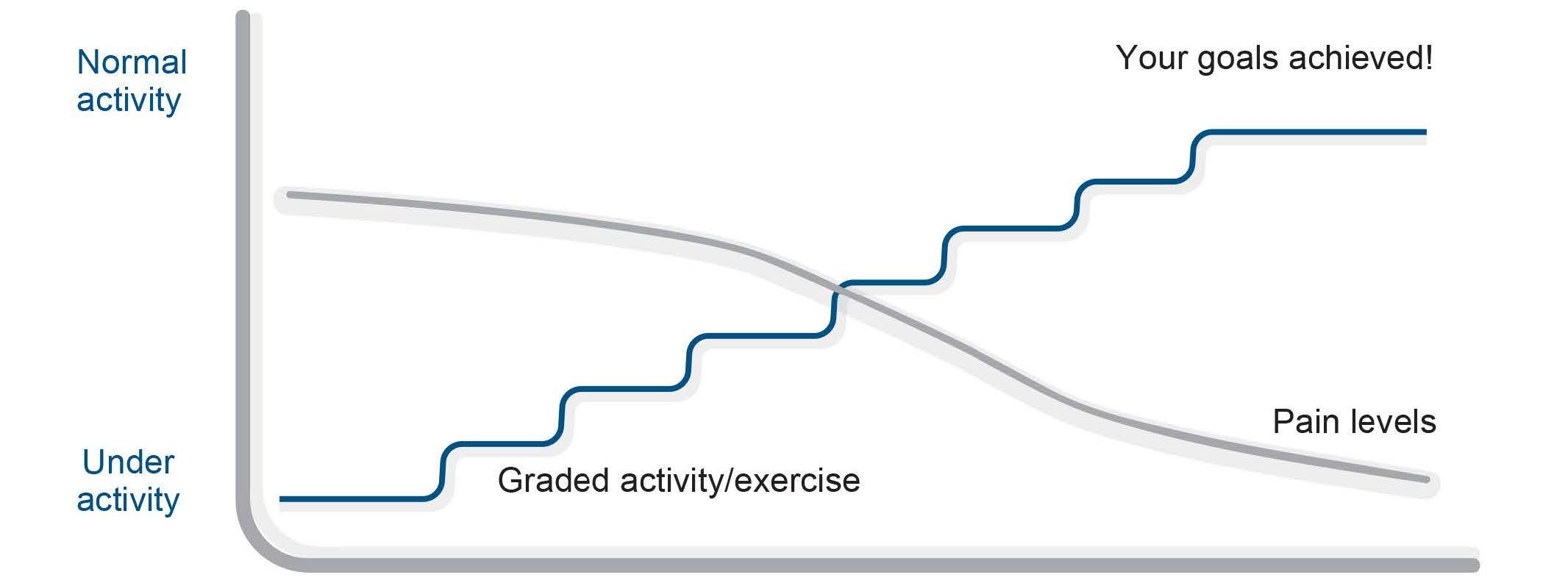Rehabilitation for complex musculoskeletal pain
Based on your scores on the previous validated questionnaire it is likely you have a complex musculoskeletal pain problem which may involve one or more of the following factors
A physical injury which may or may not be able to be accurately diagnosed
“Heightened sensitivity” of the nervous system that processes perceptions of pain
Possible psychological distress that is a part of (not the primary cause of) your pain experience
Understanding this complex musculoskeletal pain can be challenging and a free telehealth consultation with one of our expert physiotherapists may be a good starting point (see link at the bottom of this page).
However, even for complex musculoskeletal pain, a “rehabilitation” approach to gradually build up your strength is the best approach and can be tried as a self help treatment strategy. A graded activity and exercise program involves gradually increasing activities, like walking to the shop, cleaning the house or washing clothes along with specific exercises, such as step-ups, to strengthen the muscles around your injury without increasing pain. This improves your ability to perform daily activities, and leads to a quicker recovery.
Effective graded activity and exercise programs are tailored to your long-term goals, including social, work, or leisure activities you enjoyed before getting injured. It starts with low-level activities and exercises linked to these goals that gradually increase in intensity. This not only builds strength but also helps your injury adjust to more activity. As a result you can expect to achieve your long term goals. The figure below shows what this graded activity and exercise program looks like.
The curved grey line in the figure above shows your how your pain usually improves over time with graded activity and exercise. However, it is difficult to know when and by how much this improvement will occur. This is why in the early stages of your recovery you should focus on gradual increases in activity and exercise understanding that improvements in pain may take a little longer.
The time to reach your goals depends on how severe your musculoskeletal pain is but for an injury that has not recovered in 6-12 weeks it will probably take at least 3 months to get back to all your normal activity. Think about your goals and try breaking them down into long term (3-6 months), medium term (1-2 months) and short term (1-2 weeks). Playing competitive tennis with a “tennis elbow” tendon problem is a good example. A rough rehabilitation plan for someone with 12 weeks of 5/10 average tennis elbow pain would be
Week 1 - begin specific tennis elbow exercises
Week 3 - be able to do the tennis elbow exercises with 2kg. Start 5 minutes of hitting a tennis ball against a wall (forehand only) 2/day. Over the next 2 weeks increase to 10-15 minutes and add one backhand shot for every 4 forehand shots (backhand puts more force on the tendon problem)
Week 5 - be able to do high force tennis elbow exercises with 4kg. Start game practice beginning with a social hit for 2 x 15 minutes and a 5 minute break (no serving and more forehand than backhand). Increase to 45 minutes continuous hitting with some 50% serves (serving is a high force action for tennis elbow)
Week 7 - Play 1 set of social tennis building to 3 sets over the coming weeks
Week 9 - Play competition doubles 2/week building to competition singles (singles involves more force on the tendon)
As you can see planning a rehabilitation program can be complicated but with common sense people with musculoskeletal pain can slowly grade up their activity and exercise. If you are “flaring up” meaning more than 2/10 increase in your pain lasting for more than 24 hours then it is likely you need expert physiotherapy assistance. If this is the case why not try a free telehealth consultation with one of our expert practitioners by clicking the button below. Ongoing treatment by telehealth or face to face can also be provided if needed to guide your recovery.

